

A double rainbow features reversed colors in the outer (secondary) bow, with the dark Alexander's band between the bows. Although most people will not notice it because they are not actively looking for it, a dim secondary rainbow is often present outside the primary bow. Secondary rainbows are caused by a double reflection of sunlight inside the raindrops, and appear at an angle of 50-53 degrees.
As a result of the second reflection, the colors of a secondary rainbow are inverted compared to the primary bow, with blue on the outside and red on the inside. The secondary rainbow is fainter than the primary because more light escapes from two reflections compared to one and because the rainbow itself is spread over a greater area of the sky.
The next time you see a double rainbow, look closely and see if you can spot Alexander's Band, the area of sky in between the two arcs that appears darker than its surroundings. This area is named after Greek sage Alexander of Aphrodisias, who described it about 1,800 years ago.
Basically, what's happening is this: we see the primary rainbow when light rays from the sun undergo a single interaction with raindrops in the sky. The secondary (or "double") rainbow, meanwhile, is created by rays that interact twice. The Alexander's Band phenomenon occurs because raindrops in the area between rainbows are unable to send light directly to our eyes due to the angle. Therefore, the sky in this area appears darker to us because there is less light reaching our retinas.
Very dim tertiary (triple) and even quaternary (quadruple) rainbows have been photographed. These are caused by triple or quadruple reflections of sunlight inside the raindrops. Such rainbows appear on the same side of the sky as the sun, at about 40° from the sun for tertiary and 45° from the sun for quaternary rainbows. It is difficult to see these types of rainbows with the naked eye because of the sun's glare.
Higher-order rainbows were described by Felix Billet (1808-1882) who depicted angular positions up to the 19th-order rainbow, a pattern he called a "rose of rainbows". In the laboratory, it is possible to observe higher-order rainbows by using extremely bright and well collimated light produced by lasers. Up to the 200th-order rainbow was reported by Ng et al. in 1998 using a similar method but an argon ion laser beam.

Wake Forest, North Carolina - July 24, 2022
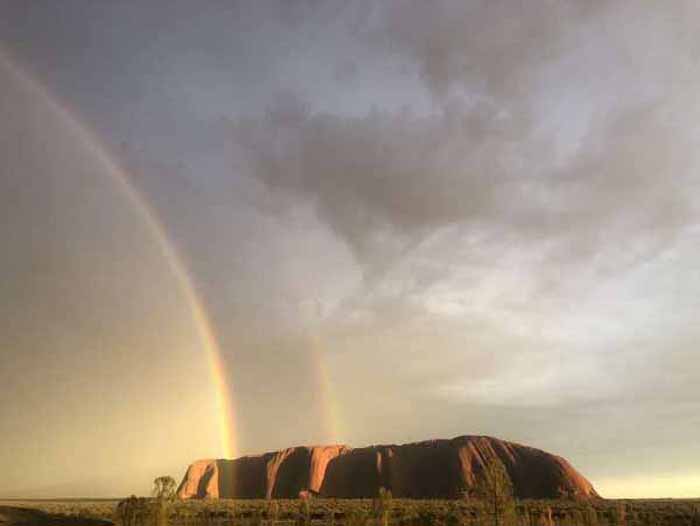
The epic 550-million-year story of Uluru and the spectacular forces that led to its formation
PhysOrg - December 30, 2021
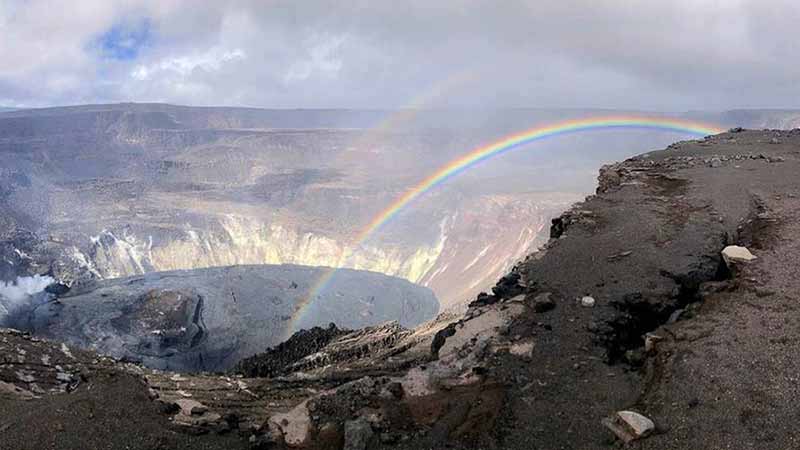
A rainbow ending in an erupting volcano?
What caused phenomenon in Hawaii park?
Sacramento Bee - February 26, 2021
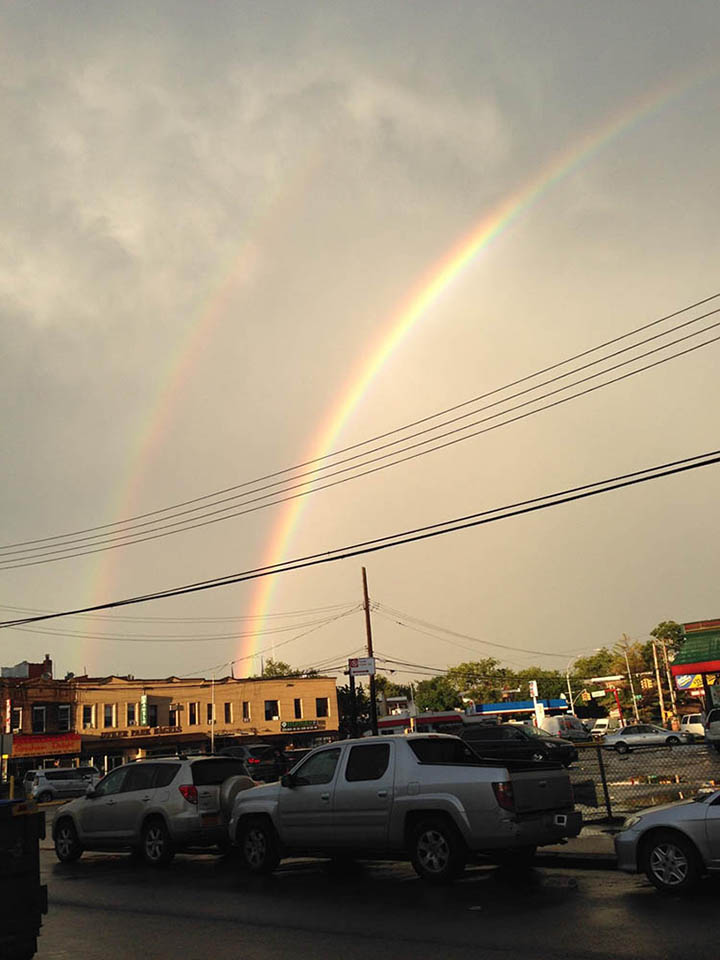
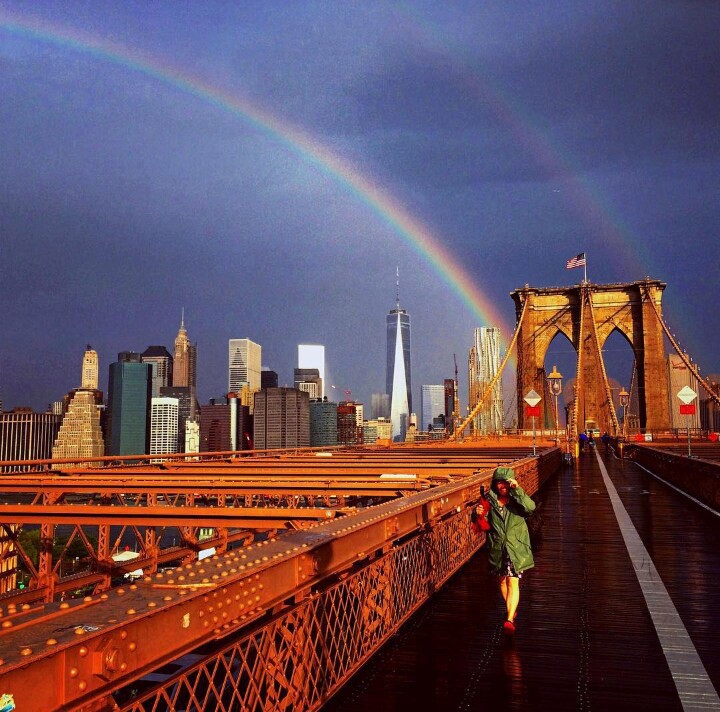
Double rainbow over the World Trade Center - Thursday September 10, 2015


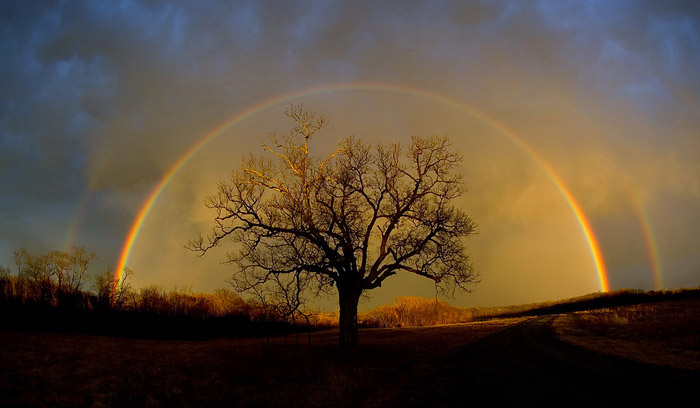
The Rainbow and the Tree

Double rainbow and supernumerary rainbows on the inside of the primary arc.
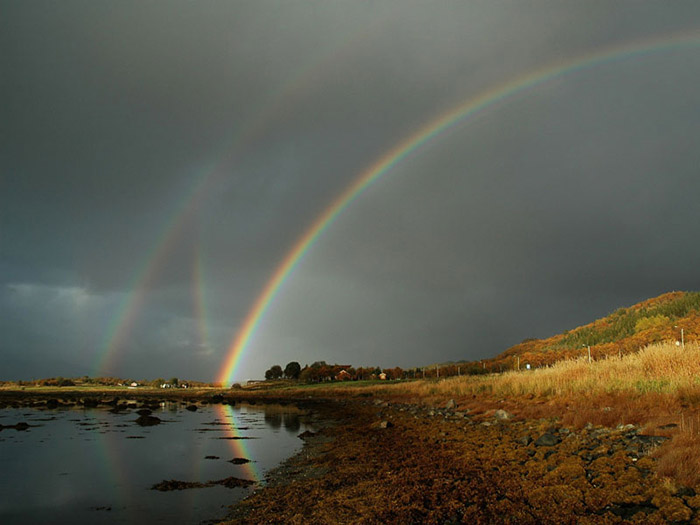
Six Rainbows at Once Across Norway
NASA - September 11, 2007
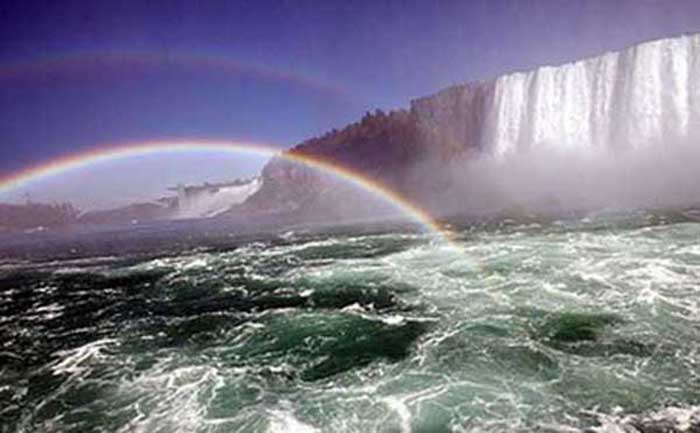
Niagara Falls seen from aboard the Maid of the Mist - AP - October 9, 2006

Tanzania Rainbow
National GeographicRainbows frame a peculiar lava formation at Ol Doinyo Lengai, a volcano in Tanzania. Maasai goddess Eng'al, who signals her wrath with eruptions and drought, is said to inhabit the summit.

Spaceweather.com - August 23, 2006
"Lately, so many rainbows have popped up around Dublin, Ireland, locals have coined a new phrase: "We call it rainbow pollution," laughs Brian Nitz. After a recent thundershower, Nitz photographed a bright double rainbow. In one exposure, he used an infra-red filter. In another exposure, he didn't. The resulting blink comparison shows the rainbow in visible vs. infrared light. Note how the infra-red 'bows are closer together than the visible bows. Also, the infrared arcs fit neatly inside their visible counterparts. This happens because the wavelength of infrared light is longer than the wavelength of visible light. Rainbows are formed by light reflecting inside raindrops. Different wavelengths mean different angles of reflection--and different-sized rainbows."
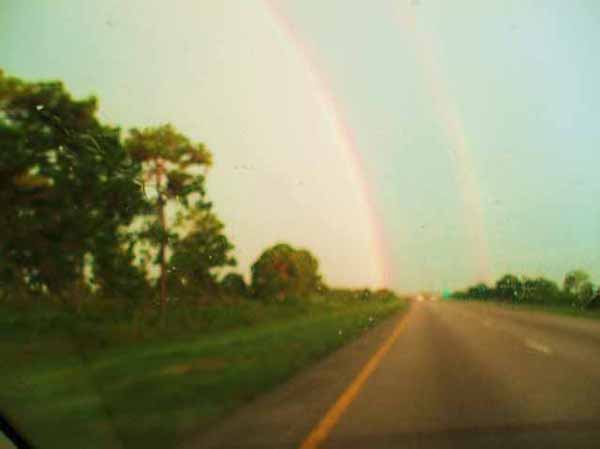
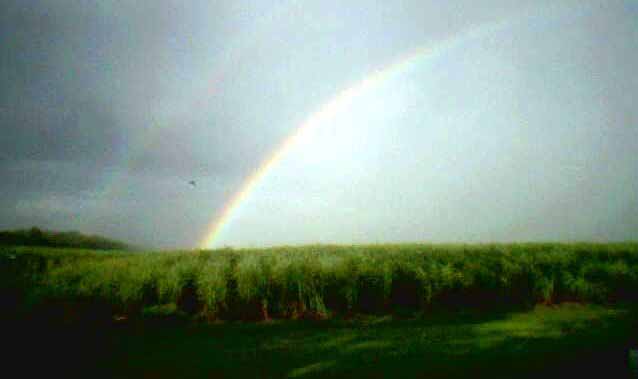
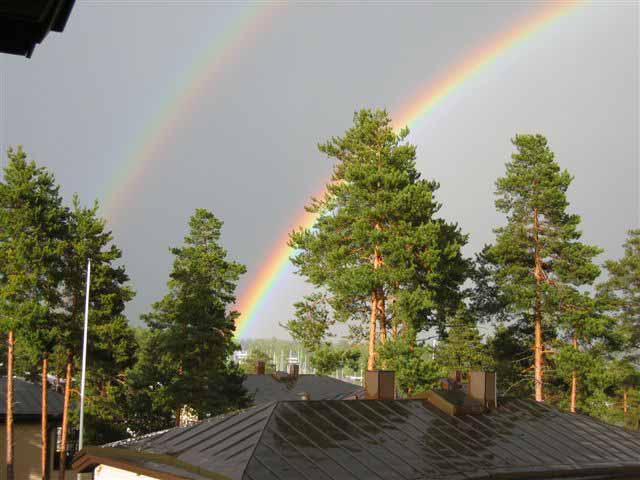


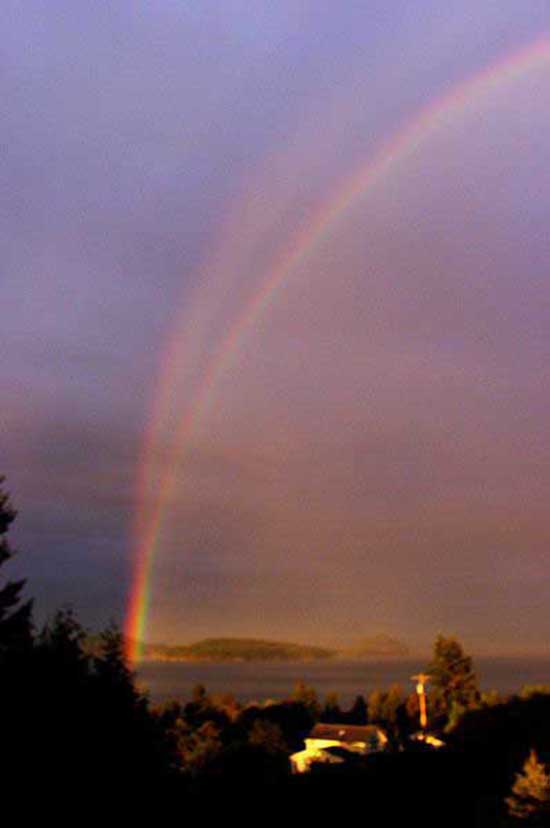
Unlike a double rainbow that consists of two separate and concentric rainbow arcs, the very rare twinned rainbow appears as two rainbow arcs that split from a single base. The colors in the second bow, rather than reversing as in a double rainbow, appear in the same order as the primary rainbow. It is sometimes even observed in combination with a secondary rainbow. The cause of a twinned rainbow is the combination of different sizes of water drops falling from the sky. Due to air resistance, raindrops flatten as they fall, and flattening is more prominent in larger water drops. When two rain showers with different-sized raindrops combine, they each produce slightly different rainbows which may combine and form a twinned rainbow.
Until recently, scientists could make only an educated guess as to why a twinned rainbow does appear, even though extremely rarely. It was thought that most probably non-spherical raindrops produced one or both bows, with surface tension forces keeping small raindrops spherical, while large drops were flattened by air resistance; or that they might even oscillate between flattened and elongated spheroids. However, in 2012 a new technique was used to simulate rainbows, enabling the accurate simulation of non-spherical particles. Besides twinned rainbows, this technique can also be used to simulate many different rainbow phenomena including double rainbows and supernumerary bows. Read more

Unlike a double rainbow which consists of two separate and concentric rainbow arcs, the very rare twinned rainbow appears as two rainbow arcs that split from a single base. The colors in the second bow, rather than reversing as in a double rainbow, appear in the same order as the primary rainbow. It is sometimes even observed in combination with a double rainbow. The explanation for a twinned rainbow is the combination of different sizes of water drops falling from the sky. Due to air resistance raindrops flatten as they fall and flattening is more prominent in larger water drops. When two rain showers with different sized raindrops combine they each produce slightly different rainbows which may combine and form a twinned rainbow.
How Strange Twinned Rainbows Form Live Science - August 9, 2012
A twinned primary rainbow produced through computer simulation. The rainbow is split because of the interaction of light with two types of water drops: some smaller, spherical ones, and some larger water drops that become nonspherical. The different shapes cause light to leave the water drops in two different directions, which causes the rainbow to split into two arcs, a study presented in August 2012 found. Double rainbows had their fifteen minutes of fame on the Internet. Now get ready for their even more mysterious cousins: twinned rainbows. New research has suggested an explanation for these exotic shows of color. Rainbows are known to form when sunlight interacts with tiny water drops in the atmosphere. As sunlight gets both reflected and refracted within the drops, it gets separated into its basic color components. Still, all the secrets of the more complex behavior of rainbows have long remained a puzzle. The most common rainbow has a single arc. The less common double rainbow, which consists of two separate, concentric arcs, has inspired Internet memes. Triple and quadruple rainbows have even been spotted. Even rarer, however, is the twinned rainbow, where two arcs split from a single base rainbow.
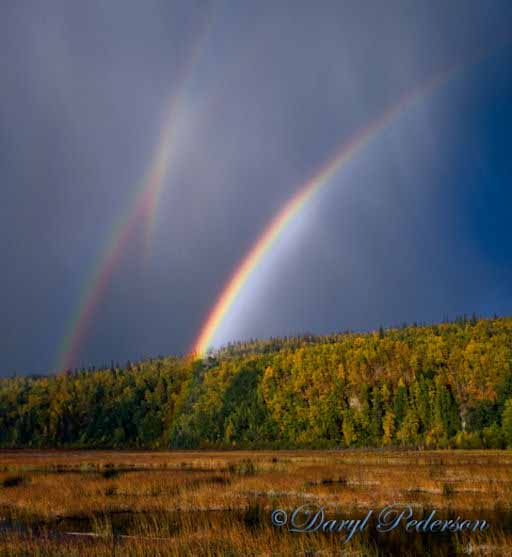

In theory, every rainbow is a circle, but from the ground, usually only its upper half can be seen. Since the rainbow's centre is diametrically opposed to the Sun's position in the sky, more of the circle comes into view as the sun approaches the horizon, meaning that the largest section of the circle normally seen is about 50% during sunset or sunrise.
Viewing the rainbow's lower half requires the presence of water droplets below the observer's horizon, as well as sunlight that is able to reach them. These requirements are not usually met when the viewer is at ground level, either because droplets are absent in the required position, or because the sunlight is obstructed by the landscape behind the observer.
From a high viewpoint such as a high building or an aircraft, however, the requirements can be met and the full-circle rainbow can be seen. Like a partial rainbow, the circular rainbow can have a secondary bow or supernumerary bows as well.
It is possible to produce the full circle when standing on the ground, for example by spraying a water mist from a garden hose while facing away from the sun.
A circular rainbow should not be confused with the glory, which is much smaller in diameter and is created by different optical processes. In the right circumstances, a glory and a (circular) rainbow or fog bow can occur together. Another atmospheric phenomenon that may be mistaken for a "circular rainbow" is the 22 degree halo, which is caused by ice crystals rather than liquid water droplets, and is located around the Sun (or Moon), not opposite it.
In certain circumstances, one or several narrow, faintly colored bands can be seen bordering the violet edge of a rainbow; i.e., inside the primary bow or, much more rarely, outside the secondary. These extra bands are called supernumerary rainbows or supernumerary bands; together with the rainbow itself the phenomenon is also known as a stacker rainbow.
The supernumerary bows are slightly detached from the main bow, become successively fainter along with their distance from it, and have pastel colors (consisting mainly of pink, purple and green hues) rather than the usual spectrum pattern.
The effect becomes apparent when water droplets are involved that have a diameter of about 1 mm or less; the smaller the droplets are, the broader the supernumerary bands become, and the less saturated their colors. Due to their origin in small droplets, supernumerary bands tend to be particularly prominent in fogbows.
Supernumerary rainbows cannot be explained using classical geometric optics. The alternating faint bands are caused by interference between rays of light following slightly different paths with slightly varying lengths within the raindrops. Some rays are in phase, reinforcing each other through constructive interference, creating a bright band; others are out of phase by up to half a wavelength, cancelling each other out through destructive interference, and creating a gap.
Given the different angles of refraction for rays of different colors, the patterns of interference are slightly different for rays of different colors, so each bright band is differentiated in color, creating a miniature rainbow. Supernumerary rainbows are clearest when raindrops are small and of uniform size. The very existence of supernumerary rainbows was historically a first indication of the wave nature of light, and the first explanation was provided by Thomas Young in 1804.